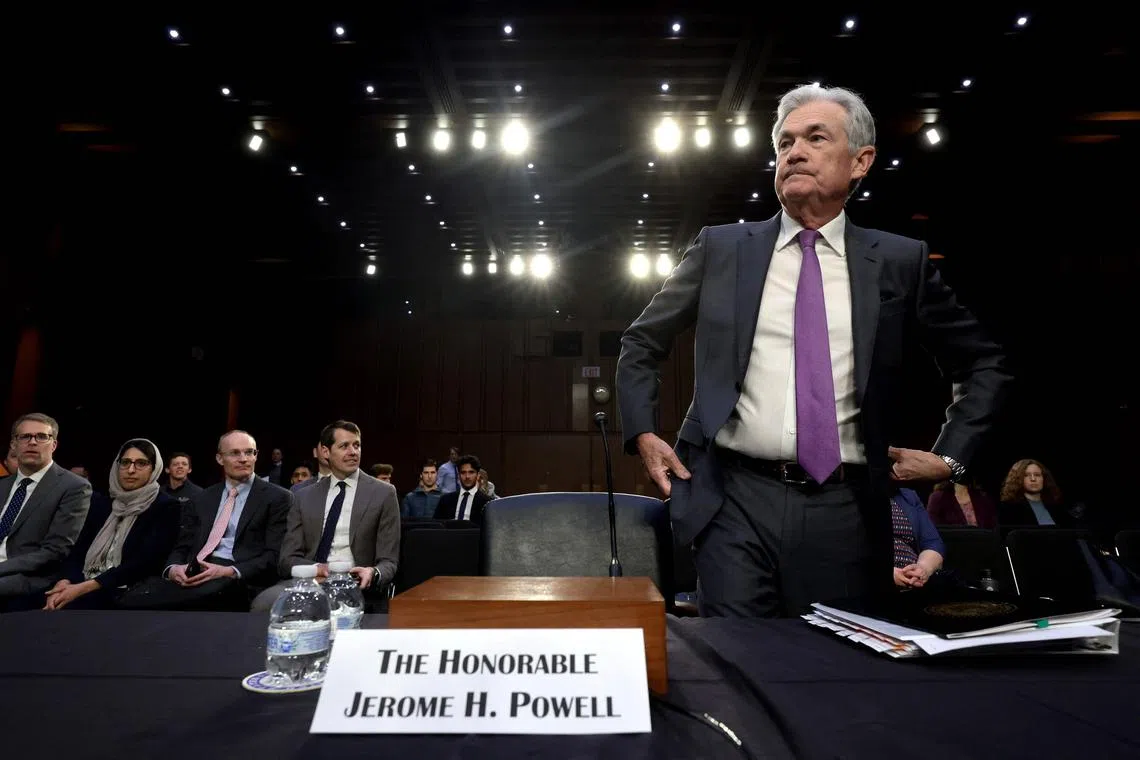Fed chief opens door to higher and possibly faster US rate hikes
Sign up now: Get ST's newsletters delivered to your inbox

US Federal Reserve Chair Jerome Powell told the Senate Banking Committee in Washington that economic data was stronger than expected.
PHOTO: AFP
Follow topic:
WASHINGTON - Federal Reserve chair Jerome Powell made clear on Tuesday that the United States central bank is prepared to react to recent signs of economic strength by raising interest rates higher than previously expected and, if incoming data remains hot, potentially returning to a quicker pace of rate increases.
His comments before the Senate Banking Committee were the clearest acknowledgment yet that recent reports showing US inflation remaining stubbornly high and the job market staying resilient are likely to shake up the policy trajectory for the Fed.
The Fed raised interest rates in 2022 at the fastest pace since the 1980s, pushing borrowing costs from near zero to above 4.5 per cent.
That initially seemed to be slowing consumer and business demand and helping inflation to moderate.
But a number of recent economic reports have suggested that inflation did not weaken as much as expected in 2022 and was higher than expected in January, while other data showed hiring remains strong and consumer spending picked up at the start of 2023.
While some of that momentum could have been owing to the mild January weather – conditions that allowed for shopping trips and construction – Mr Powell said the unexpected strength would probably require a stronger policy response from the Fed.
“The latest economic data have come in stronger than expected, which suggests that the ultimate level of interest rates is likely to be higher than previously anticipated,” he told the committee.
Fed officials projected in December that rates would rise to a peak of 5 per cent to 5.25 per cent, with a few pencilling in a slightly higher 5.2 per cent to 5.5 per cent.
Mr Powell suggested that the peak rate would need to be adjusted by more than that, without specifying how much more.
He even opened the door to faster rate increases if incoming data – which includes a jobs report on Friday and a fresh inflation report due next week – remains hot.
The Fed repeatedly raised rates by three-quarters of a point in 2022, but slowed to half a point in December and a quarter point in early February.
“If the totality of the data were to indicate that faster tightening is warranted, we would be prepared to increase the pace of rate hikes,” Mr Powell said.
Before his remarks, markets were heavily prepared for a quarter-point move at the Fed’s March 21-22 meeting.
After his opening testimony, investors increasingly bet that the central bank would make a half-point move in March, stock prices lurched lower, and a closely watched Wall Street recession indicator pointed to a greater chance of a downturn.
The S&P 500 ended Tuesday down about 1.5 per cent.
When the Fed raises interest rates, it slows consumer spending on big credit-based purchases like houses and cars and can dissuade businesses from expanding on borrowed money.
As demand for products and workers cools, wage growth eases and unemployment may even rise, further slowing consumption and causing a broader moderation in the economy.
But, so far, the job market has been very resilient to the Fed’s moves, with the lowest unemployment rate since 1969, rapid hiring and robust pay gains.
Some lawmakers grilled the Fed chair on Tuesday over what the central bank expected to do to the labour market with its policy adjustments.
Democratic Senator Elizabeth Warren, suggested that the Fed was trying to “throw people out of work” and that millions of people stood to lose their jobs if unemployment rose as much as central bankers expected.
Mr Powell said: “I would explain to people, more broadly, that inflation is extremely high, and that it is hurting the working people of this nation badly.
“We are taking the only measures that we have to bring inflation down.” NYTIMES

